________________
ANTAKRTA-DASANGA (AMTAGADA-DASÃO)
49
the eleven angas (to the exclusion of the twelfth called Drstivāda). He fulfilled the twelve avowed ways of a mendicant, bhikkhupadimão, miscalled 'monastic standards '1 along with the gunaratna austerity for sixteen months. He took at last farewell, and climbed up Mt. Satruñjaya (Settuñja), on the summit of which he bravely met his end by a month's starvation, obtaining siddhi.
There are inter-allusions to the story of Meghakumāra which is fully narrated in the Nāyādhammakahā, and to that of Mahadbala in the Bhagavatī Sūtra or Vyākhyā-prajñapti.
The remaining nine stories and lessons are of the same type.
The second division contains the stories of eight Yādava princes, Akşobhya, Sāgara, Samudra, Himavat, Acala, Dhāraņa, Pūraņa, and Abhicandra, to the exclusion of Stimita and Vişnu. These narratives agree substantially with those in the first division. As for the two points of difference, the text wants us to understand that here gunaratna is the single form of austerity, and that the period of effort is sixteen years instead of twelve. This second list of the princes born in the family of Andhakavrsni and Dhāriņi differs in respect of three names from the first. As known to the commentator Abhayadeva, Kunti and Mädri were the two younger sisters to Prince Vişnu.
The third division consists of the stories and examples of thirteen persons, Anita, Anantasena, Ajitasena, Anighacarita, Devasena, Satrusena, Sārana, Gaja, Sumukha, Dummukha, Kupana, Dāruka, and Anādrsti.
The story of Anita is introduced with a description of the city of Bhaddilapura which was the capital of king Jitasatru. There was a beautiful garden by the name of Srivana on its south-east side. In that city Anita was born to Nāga, a rich banker, by his wife Sulasā. He was brought up in the midst of enormous wealth. He was placed in his eighth year under a tutor for training in sciences and arts. When he had passed his boyhood, his parents made him take the hands of thirty-two daughters of wealthy banker a day. This is followed by an exaggerated account of the wedding presents received by him. It was at the garden of Srivana that he happened to meet Ariţthanemi. The sequel of the story is similar to the story of Prince Gotama.
two points of difference to be noted are: (1) that he studied the fourteen pūrvas instead of the eleven angas, and (2) that his period was twenty years.
1 Modi, op. cit., pp. 100ff.




